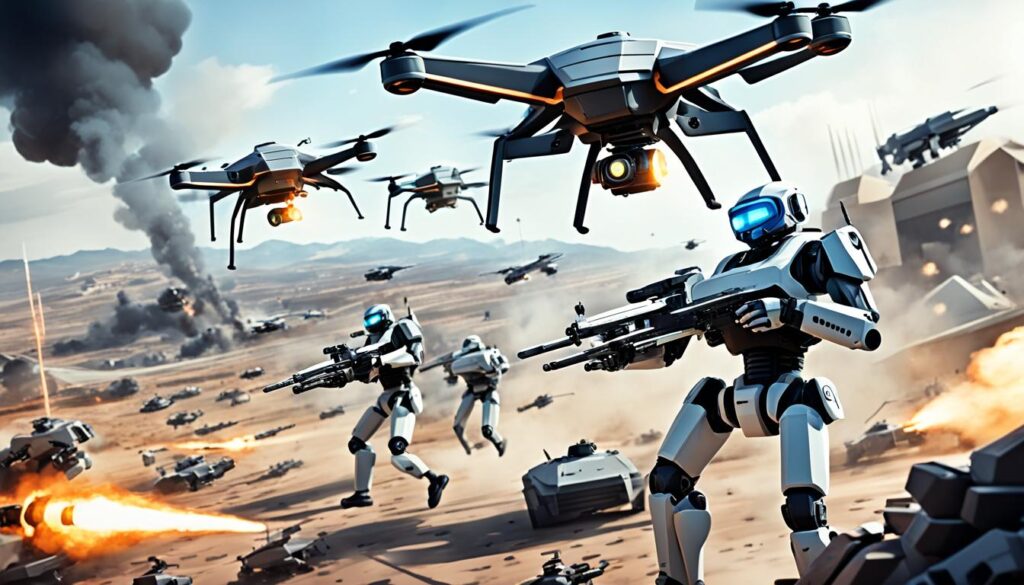Did you know the AI market is expected to hit $1.3 trillion by 2032? This growth will change many fields, including the military. Artificial intelligence is changing how wars are fought and planned.
The Pentagon is leading this change with a focus on AI. They’re putting a lot into data, computing power, and AI for the Combined Joint All-Domain Command and Control (CJADC2). This move is changing how militaries work, making them more effective on the battlefield and in making quick decisions.
But it’s not just the U.S. China plans to be a top AI power by 2030. They want to grow their Special Operations Forces and use AI in the military. This shows how important machine learning is becoming for defense worldwide.
Looking into AI’s impact on the military, we see changes in strategy, logistics, recruitment, and ethics in war. Get ready to see how defense is evolving with artificial intelligence.
The Rise of AI in Military Applications
AI is changing how military operations work fast. The Department of Defense made the Joint Artificial Intelligence Center to lead in AI for military use. This shows how important AI is becoming in defense plans.
Current AI Market Growth and Projections
Experts say the AI market will hit almost $60 billion soon. This big investment changes military uses a lot. By 2030, AI could add $15.7 trillion to the global GDP. This boost will touch many areas, including the military.
AI’s Potential to Increase Military Productivity
AI could make business 40% more productive. This means big gains for military defense and operations too. Neural networks in the military are great at recognizing images and translating languages. These AI tools are also good at spotting military assets and important targets.
The Need for Quick Decisions and Agile Methods in Battle
Fast decisions are key in combat. AI helps by gathering and making sense of lots of data from different places. This helps military leaders make smart choices, even when under a lot of pressure. Big data analytics in military actions turn a lot of data into useful info for leaders.
Autonomous weapon systems are getting more common. The Pentagon has updated its rules on these systems to match AI progress. The new rules focus on safe and right use. Using AI with drones helps keep military people safe during fights.
Transforming Military Strategy with AI
AI is changing how military strategies work, bringing new tactics to the battlefield. Nations are quickly adopting this technology, making the war zone change fast. The United States is leading with a “third offset” strategy, focusing on AI, autonomy, and robotics to stay ahead.
Now, intelligent robots are fighting in real battles. AI systems are getting smarter, helping military leaders make quick decisions. They can handle huge amounts of data, giving commanders the info they need fast. This makes troops more aware and quicker to act.
The Pentagon has a 2023 plan to use AI for better decision-making on the battlefield. It aims for five main goals: better understanding the battlefield, planning faster, quick attacks, reliable support, and efficient operations. This plan is all about being quick and adaptable with AI.
As AI gets better, experts think we might see “hyperwar” – a war where decisions happen almost instantly. This means less human control. Being ready for this change is key to winning future battles.
How Will AI Effect the Military: Key Areas of Impact
Artificial intelligence is changing warfare in many ways. The United States Department of Defense has been working on ethical AI rules for over ten years. They show this in their Data, Analytics, and AI Adoption Strategy.
Enhanced Battlefield Effectiveness
Machine learning is changing how battles are fought. Recently, Russia showed how AI can control 80 UAVs over Syrian battlefields at once. This shows AI’s power in managing complex operations efficiently.
Improved Decision-Making Processes
AI is changing how military leaders make decisions. These systems can handle huge amounts of data to give tactical benefits. In a DARPA competition, an AI system beat human F-16 pilots 5-1 in dogfights. This shows AI’s potential in combat.
Advanced Training and Simulation
The military is using AI to improve training. AI simulations offer realistic and adaptable training that goes beyond old methods. The National Security Commission on Artificial Intelligence says we need an AI-ready workforce. This is pushing for special AI training for different military jobs.
AI-Driven Logistics and Maintenance in the Military
The military is using big data analytics and machine learning to change how it handles logistics and maintenance. With AI tactics, the armed forces are getting better at what they do and ready faster. The Defense Logistics Agency has found over 350 high-risk suppliers using AI and machine learning to spot fraud.
AI is changing how the military manages its supply chains. A study found that adding AI to Army supply chains could make things 20% more efficient. These systems can predict when parts need to be replaced, saving money and keeping things running smoothly.
In the heat of battle, AI is a game-changer. The Army’s Telemedicine & Advanced Technology Research Center is working on AI for medical aid stations. Companies like Charles River Analytics are making AI tools for treating wounded soldiers, which could save many lives.
The Department of Defense is all in on AI innovation with its new strategy. Task Force Lima is looking into and using generative AI across the DoD. This focus on AI in logistics and maintenance is key for the US military to stay ahead, given China and Russia’s AI investments.
Artificial Intelligence and Military Recruitment
The armed forces are using neural networks and machine learning to change how they recruit. AI helps make recruitment better and more efficient.
Leveraging AI for Targeted Recruitment
The U.S. Army website gets 2.5 million visitors every month, with 35% being women. This info lets AI make recruitment messages just for them. AI looks at what users do online to find the right people and send them messages that matter.
Improving Candidate Selection Processes
AI makes picking new recruits better. It looks at who applies and guesses who will do well. This way, it saves time and makes sure people fit their roles better.
AI-Powered Chatbots for Recruitment
The military is making AI chatbots to talk to potential recruits. These bots answer questions, share info, and help with applying. Both men and women are making these bots to reach more people.
As AI gets better, it’s changing how the military finds new members. It helps with finding the right people and makes the process smoother. This tech is helping build a stronger, more varied military for the future.
AI’s Role in Military Cybersecurity
AI is changing the game in military cybersecurity. The market for military cybersecurity is expected to grow by $15.11 billion from 2022 to 2027. This growth is thanks to the increasing use of AI and machine learning for defense. These technologies make network security more efficient and cut down on mistakes.
AI is also helping fight against new AI cybersecurity threats. To stay ahead, AI systems are being used to find and develop new ways to protect us. They keep people, communication networks, and data safe from unauthorized access.

Big data analytics is changing how we handle threats in the military. AI can spot patterns in cyber threats and make tools to fight back. This is key in stopping tech failures during battles.
Adding AI to cybersecurity systems makes protection stronger and speeds up how we handle incidents. It helps find complex cyber attacks faster and assess risks better. This means we can respond quicker and more effectively.
In the future, the military will need to update its policies and invest in AI. This means changing how we buy technology and working closer with industry and schools. These steps are vital for staying ahead in a world filled with digital threats.
Autonomous Weapons Systems and Ethical Considerations
The rise of autonomous weapon systems in modern warfare has sparked intense debate. As AI warfare tactics evolve, military leaders face ethical dilemmas. They must navigate the complex issues of these advanced technologies.
The Pentagon’s AI Ethical Principles
The Department of Defense has set AI ethical principles for developing autonomous systems. These principles aim for responsible and fair use of AI in military operations. The DOD Directive 3000.09 outlines policies for autonomous and semi-autonomous weapon systems. It stresses human control in key decisions.
Balancing Autonomy and Human Control
AI decision support systems in the military bring big benefits. They can tackle “dull, dirty, or dangerous” missions better than humans. For example, a TALON robot costs $230,000, while sending a soldier to Afghanistan costs about $850,000 a year.
However, the ethical concerns about AI making lethal decisions are still there.
International Concerns and Potential Regulations
The global community is worried about autonomous weapons. In 2015, over 3,000 AI and robotics researchers signed a letter calling for a ban. This shows the need for international rules on AI warfare tactics.
As the field moves forward, finding a balance between military efficiency and ethics is key.
The Future of AI in Warfare and Defense
Artificial intelligence is changing the way we fight wars today. The Pentagon is leading the charge with projects like the Combined Joint All-Domain Command and Control. This effort is making AI more important in military plans. It’s also changing how we buy new tech and encouraging innovation from both old and new companies.
AI tactics in war are changing fast, with more unmanned drones on the battlefield. These drones, powered by machine learning, are changing how we see war. They can quickly analyze huge amounts of data, spot patterns, and find threats.

The U.S. military is putting a lot into AI-driven vehicles, drones, and robots for different tasks. These systems are changing things like logistics, maintenance, and cybersecurity. AI can now quickly go through intelligence reports and satellite images, helping commanders make better decisions.
But, using AI in war also brings up ethical questions. Military leaders have different views on AI technologies, which will affect future plans. The idea of AI controlling deadly weapons is a big debate. People are talking about how to balance tech progress with human control in war.
Looking ahead, AI will be key in shaping military plans and defense work. The big challenge is using its power while dealing with ethical and practical issues that come with it.
Conclusion
Artificial intelligence is changing how wars are fought and defended. It’s making the military better in many ways, like improving how battles are fought and managing resources. AI will be key in future military plans.
AI is making decisions faster and more accurately. For example, in 2020, an AI system beat a top human pilot in a virtual fight. This shows how AI can change military strategies.
But, there are also worries about AI. Some worry about losing control over when and how to use force. As countries like China plan to fully modernize their military by 2035, the U.S. is speeding up its AI use to stay ahead. This race shows we need rules and guidelines for using AI in the military responsibly.
